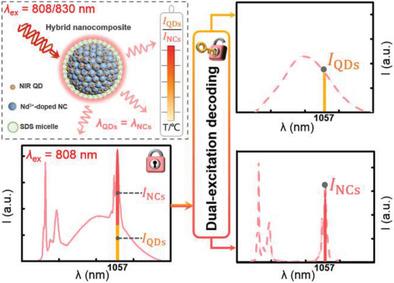Our official English website, www.x-mol.net, welcomes your feedback! (Note: you will need to create a separate account there.)
A Dual‐Excitation Decoding Strategy Based on NIR Hybrid Nanocomposites for High‐Accuracy Thermal Sensing
Advanced Science ( IF 15.1 ) Pub Date : 2020-08-25 , DOI: 10.1002/advs.202001589 Shaohua Yu 1, 2 , Jin Xu 1, 3 , Xiaoying Shang 1 , Wei Zheng 1, 3 , Ping Huang 1, 3 , Renfu Li 1, 3 , Datao Tu 1, 3 , Xueyuan Chen 1, 2, 3
Advanced Science ( IF 15.1 ) Pub Date : 2020-08-25 , DOI: 10.1002/advs.202001589 Shaohua Yu 1, 2 , Jin Xu 1, 3 , Xiaoying Shang 1 , Wei Zheng 1, 3 , Ping Huang 1, 3 , Renfu Li 1, 3 , Datao Tu 1, 3 , Xueyuan Chen 1, 2, 3
Affiliation

|
Optical thermal sensing holds great promise for disease theranostics. However, traditional ratiometric thermometry methods, in which intensity ratio of two nonoverlapping emissions is defined as the thermosensitive parameter, may have a limited accuracy in temperature read‐out due to the deleterious interference from wavelength‐ and temperature‐dependent photon attenuation in tissue. To overcome this limitation, a dual‐excitation decoding strategy based on NIR hybrid nanocomposites comprising self‐assembled quantum dots (QDs) and Nd3+ doped fluoride nanocrystals (NCs) is proposed for thermal sensing. Upon excitation at 808 nm, the intensity ratio of two emissions at identical wavelength (1057 nm) from QDs and NCs, respectively, is defined as the thermometric parameter R. By employing another 830 nm laser beam following the same optical path as 808 nm laser to exclusively excite QDs, the two overlapping emissions can be easily decoded. The acquired R proves to be inert to the detection depth in tissue, with a minimized temperature reading error of ≈2.3 °C at 35 °C (at a depth of ≈1.1 mm), while the traditional thermometry mode based on the nonoverlapping 1025 and 863 nm emissions may exhibit a large error of ≈43.0 °C. The insights provided by this work pave the way toward high‐accuracy deep‐tissue biosensing.
中文翻译:

基于近红外混合纳米复合材料的双激励解码策略用于高精度热传感
光学热传感技术在疾病治疗学上具有广阔的前景。但是,传统的比例测温方法将两个不重叠发射的强度比定义为热敏参数,由于受组织中与波长和温度有关的光子衰减的有害干扰,温度读出的准确性可能受到限制。为了克服这一局限性,提出了一种基于NIR杂化纳米复合材料的双激发解码策略,该复合材料包括自组装量子点(QD)和Nd 3+掺杂的氟化物纳米晶体(NC)。在808 nm激发时,分别从QD和NC发出的相同波长(1057 nm)处的两种发射的强度比定义为测温参数R。通过沿与808 nm激光相同的光路采用另一个830 nm激光束专门激发QD,可以轻松解码两个重叠发射。事实证明,所获得的R对组织中的检测深度是惰性的,在35°C(约1.1 mm的深度)时,最小的温度读取误差约为2.3°C,而传统的测温模式基于不重叠的1025和863 nm的发射可能会显示≈43.0°C的较大误差。这项工作提供的见解为高精度的深层组织生物传感铺平了道路。
更新日期:2020-10-22
中文翻译:

基于近红外混合纳米复合材料的双激励解码策略用于高精度热传感
光学热传感技术在疾病治疗学上具有广阔的前景。但是,传统的比例测温方法将两个不重叠发射的强度比定义为热敏参数,由于受组织中与波长和温度有关的光子衰减的有害干扰,温度读出的准确性可能受到限制。为了克服这一局限性,提出了一种基于NIR杂化纳米复合材料的双激发解码策略,该复合材料包括自组装量子点(QD)和Nd 3+掺杂的氟化物纳米晶体(NC)。在808 nm激发时,分别从QD和NC发出的相同波长(1057 nm)处的两种发射的强度比定义为测温参数R。通过沿与808 nm激光相同的光路采用另一个830 nm激光束专门激发QD,可以轻松解码两个重叠发射。事实证明,所获得的R对组织中的检测深度是惰性的,在35°C(约1.1 mm的深度)时,最小的温度读取误差约为2.3°C,而传统的测温模式基于不重叠的1025和863 nm的发射可能会显示≈43.0°C的较大误差。这项工作提供的见解为高精度的深层组织生物传感铺平了道路。



























 京公网安备 11010802027423号
京公网安备 11010802027423号